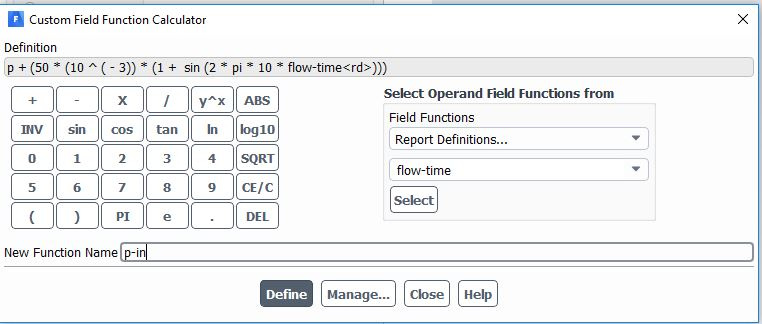-
-
September 9, 2020 at 8:35 am
ananyas
SubscriberHello,
I am trying to simulate a system with different volumes and a heat source. The idea is that I initialize the system with the heater temperature set. After the thermal equilibrium is reached [say 1 sec] as in the figure below. I want to introduce an energy source term (or atleast temperature term) for eg. 10 [W/m^3] * (1 + sin (10[Hz] * 2 * PI * 1 [rad / sec / Hz] * t)) . I have following issues:
- Do I have to use patching or I can just introduce an "energy source" in the cell zone condition and run the calculation?
- If I have to use patching tool, there is no energy variable and even for temperture variable I can't provide a periodic function of the form 10 [K] * (1+sin(10[Hz] * 2 * PI * 1[rad / sec / Hz] * t)).
How can I patch/add the energy/temperature term for a particular cell zone after some time in transient simulation?
Ananya
September 9, 2020 at 12:14 pmRob
Forum ModeratorYou have patching to set an initial condition and then energy sources or temperature FIX to set a cell zone condition. From your description I think the latter two may be of use. nSeptember 9, 2020 at 12:28 pmananyas
SubscriberHello Rob,nThanks for the reply.nThe problem is, after 1 sec of simulation [thermal equilibrium], I want to introduce an energy source term. How can I do this? If I just turn on the energy source term, specify a energy term and run the calculation again after 1 sec, will that be correct way or I have to patch the source term to the cell zone and then run the calculation. Which of the two is correct method. It wasn't so clear from your previous reply.nSeptember 9, 2020 at 1:59 pmRob
Forum ModeratorIt depends. If you want to switch just stop the model & change the cell zone settings, the calculation activities (solution steering) may be of use, but doing it manually may be safer. nSeptember 9, 2020 at 3:00 pmananyas
SubscriberJust a quick followup question,nFrom what I understood, if I introduce the energy source term after 1 sec (~5000 iterations) and run the calculations, then for iterations beginning from 5001, the system solution will contain the effect due to the energy term as well. Right?nSeptember 10, 2020 at 1:12 amKarthik Remella
AdministratorYes, that is right.nSeptember 10, 2020 at 11:03 amananyas
SubscriberI am trying to compare both the methods mentioned above. For one system I use pressure equivalent energy using energy source term and for other system patching the pressure directly. I use field function to provide the pressure of the form Pstatic + 50[mPa](1+sin(wt)). nPlease refer the figure. Is the way of defining the pressure field function correct? The frequency that I specify in the field function is angular frequency or radial?.September 10, 2020 at 11:08 amKarthik Remella
AdministratorYour units have to be consistent when using Fluent expressions. Please take a look into Chapter 5 (Fluent Users Guide).nThis should help you with the details.nThanks.nKarthiknSeptember 10, 2020 at 1:36 pmananyas
SubscriberI know that we have to make sure that the units have to be consistent in case of expressions. IN case of field functions, we don't define the units. Please have a look at the figure below. I want to patch this pressure p-in on one of the volumes, using custom field functions. Is the pressure definition correct? The frequency that I specify in the field function is angular frequency or radial? nPS: I am not talking about expressions, but about custom field functions. I didn't find much information about field functions in the guide n n
September 10, 2020 at 2:03 pm
n
September 10, 2020 at 2:03 pmRob
Forum ModeratorI'm fairly sure it's radians in Fluent, but keep an eye on the results to check. Depending on what you're doing you may be better off with Expressions. n I'd also suggest keeping the function simple so 50*(10^(-3)) would be better written as 0.05 nSeptember 10, 2020 at 2:17 pmananyas
SubscriberThanks for the reply Rob. I'll simplify the function. nWE can only use constant or field function for patching. nAre you telling that we can somehow use expressions for patching physical quantities as well? That would make my life so much easier.nSeptember 10, 2020 at 3:33 pmRob
Forum ModeratorAh, maybe not, I'd missed that you were patching that value. nSeptember 10, 2020 at 3:51 pmKarthik Remella
Administrator,nI missed this as well. You were talking about CFFs and patching all along. My bad! nKarthiknSeptember 11, 2020 at 10:42 amRob
Forum Moderatortechnically he asked about source terms, so I think we're good. nmake sure you read the release notes for 2021R1 when it's out, they're interesting (if you like that sort of thing) and will tell you what's new in the code. nViewing 13 reply threads- The topic ‘Ansys fluent patch/add energy/temperature term after some time in transient simulation’ is closed to new replies.
Ansys Innovation SpaceTrending discussionsTop Contributors-
3762
-
1333
-
1168
-
1090
-
1014
Top Rated Tags© 2025 Copyright ANSYS, Inc. All rights reserved.
Ansys does not support the usage of unauthorized Ansys software. Please visit www.ansys.com to obtain an official distribution.
-
The Ansys Learning Forum is a public forum. You are prohibited from providing (i) information that is confidential to You, your employer, or any third party, (ii) Personal Data or individually identifiable health information, (iii) any information that is U.S. Government Classified, Controlled Unclassified Information, International Traffic in Arms Regulators (ITAR) or Export Administration Regulators (EAR) controlled or otherwise have been determined by the United States Government or by a foreign government to require protection against unauthorized disclosure for reasons of national security, or (iv) topics or information restricted by the People's Republic of China data protection and privacy laws.












